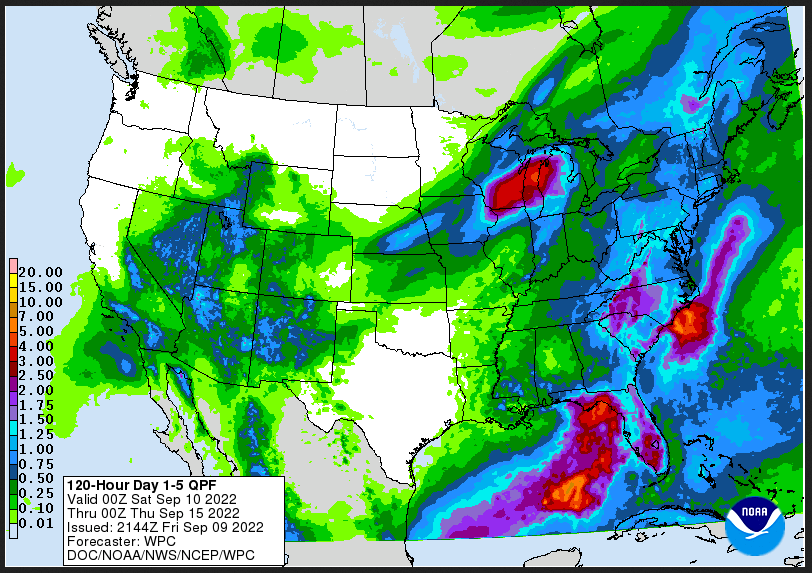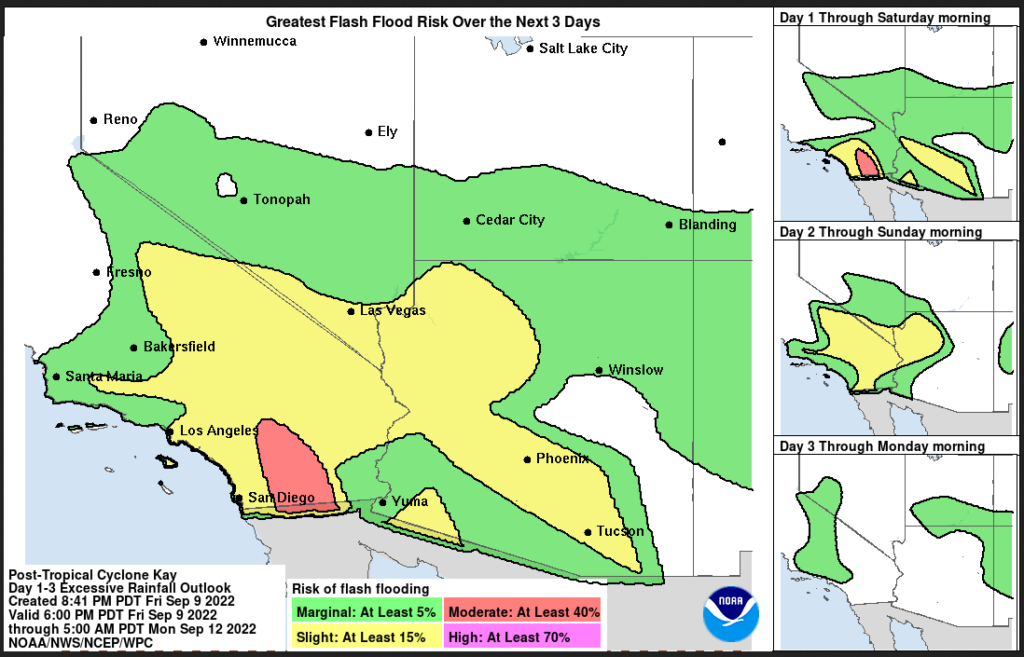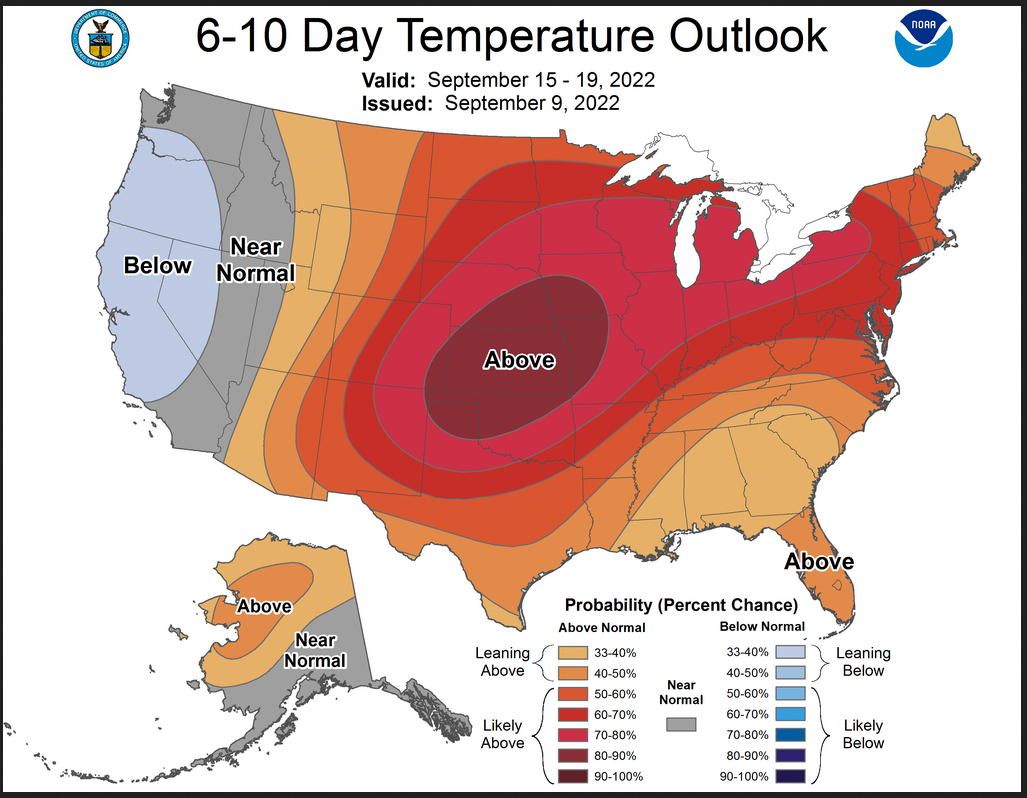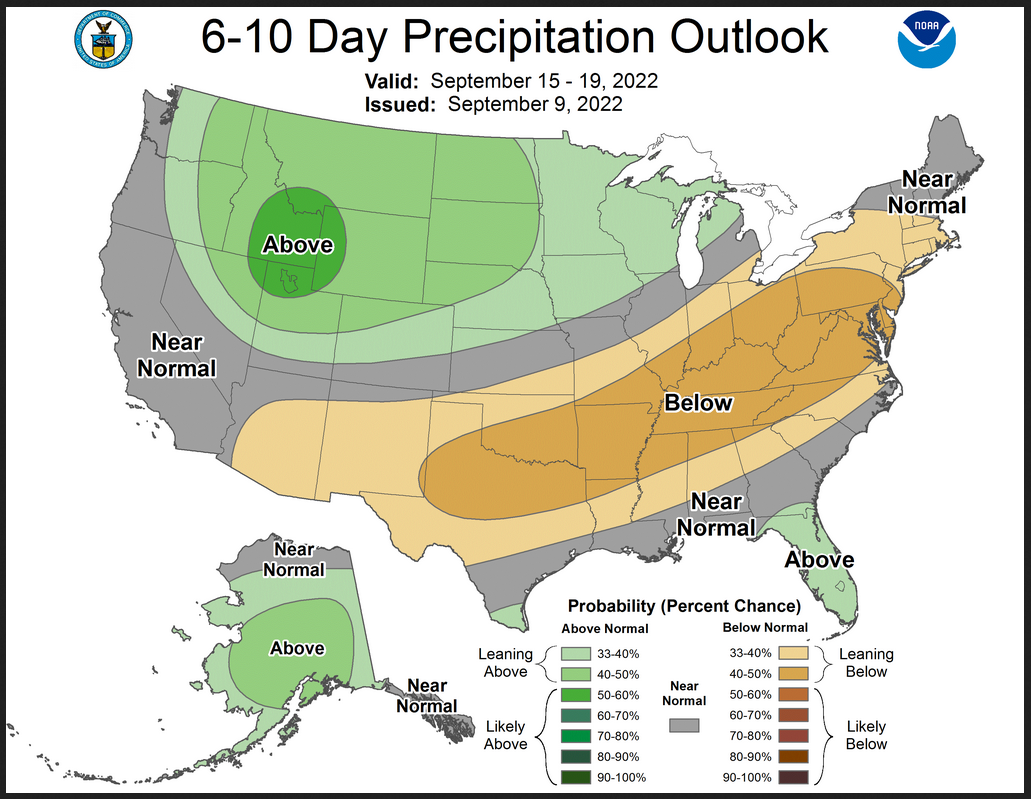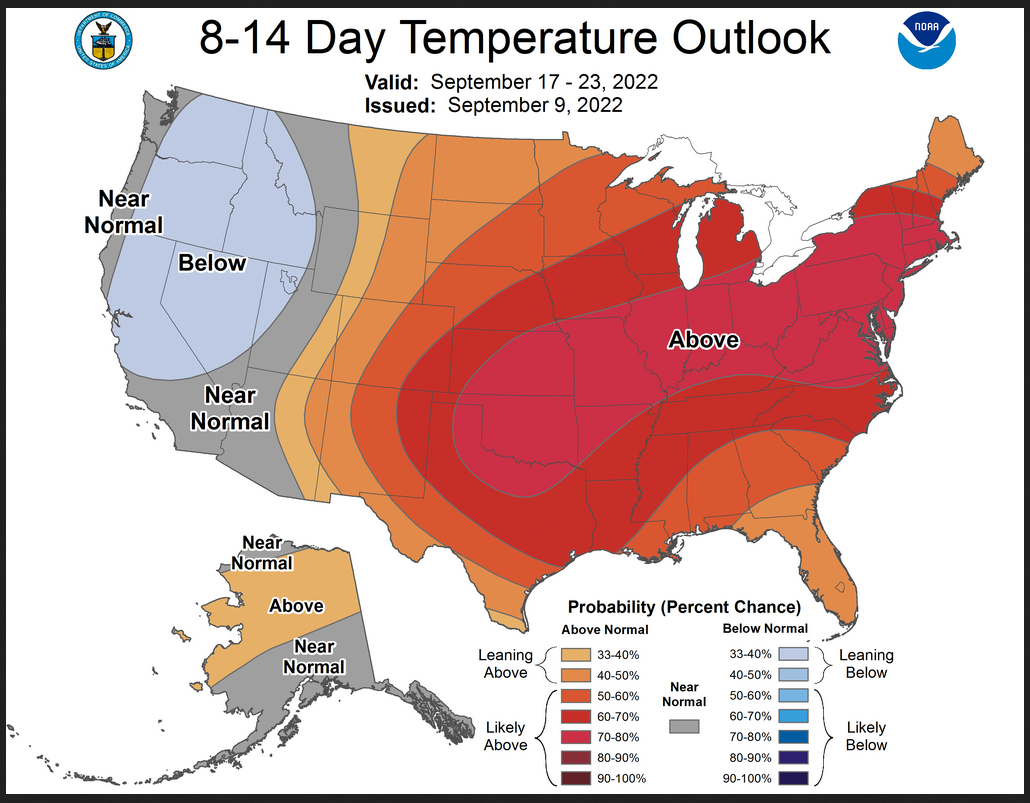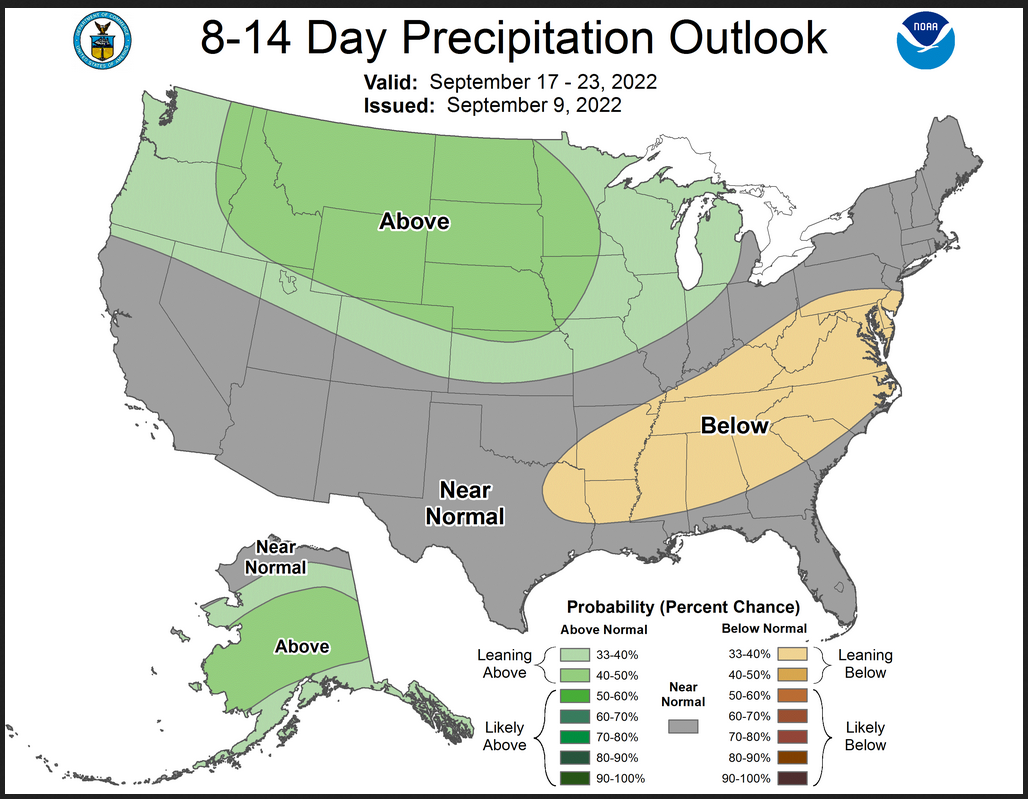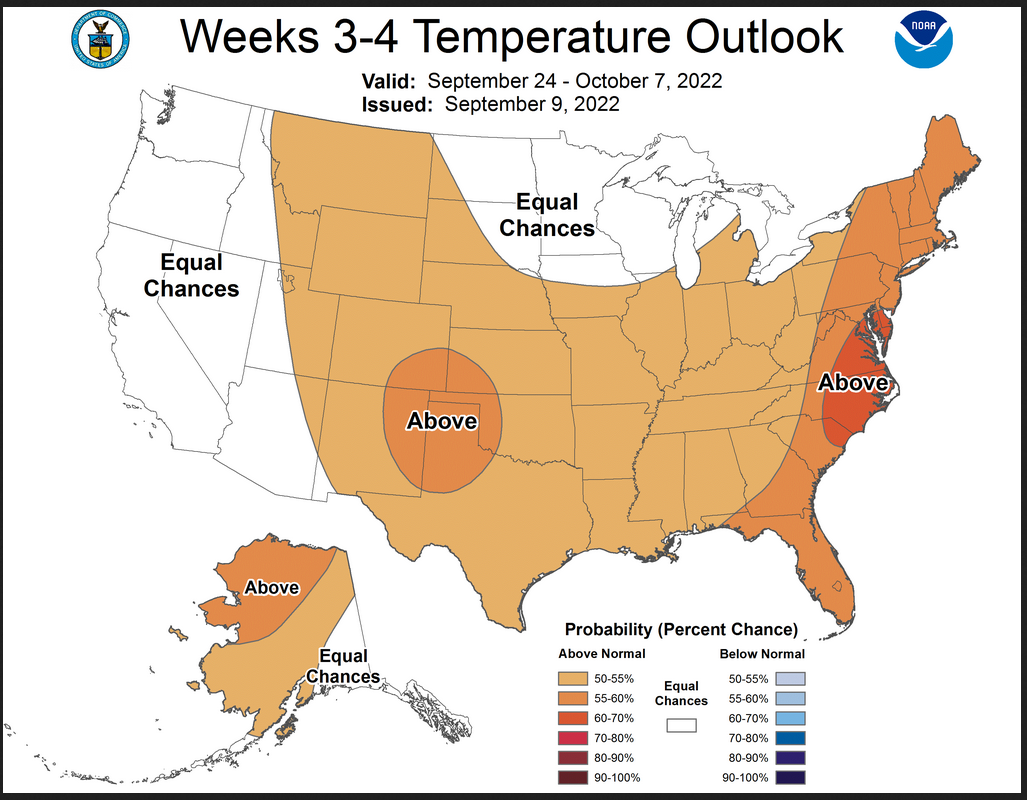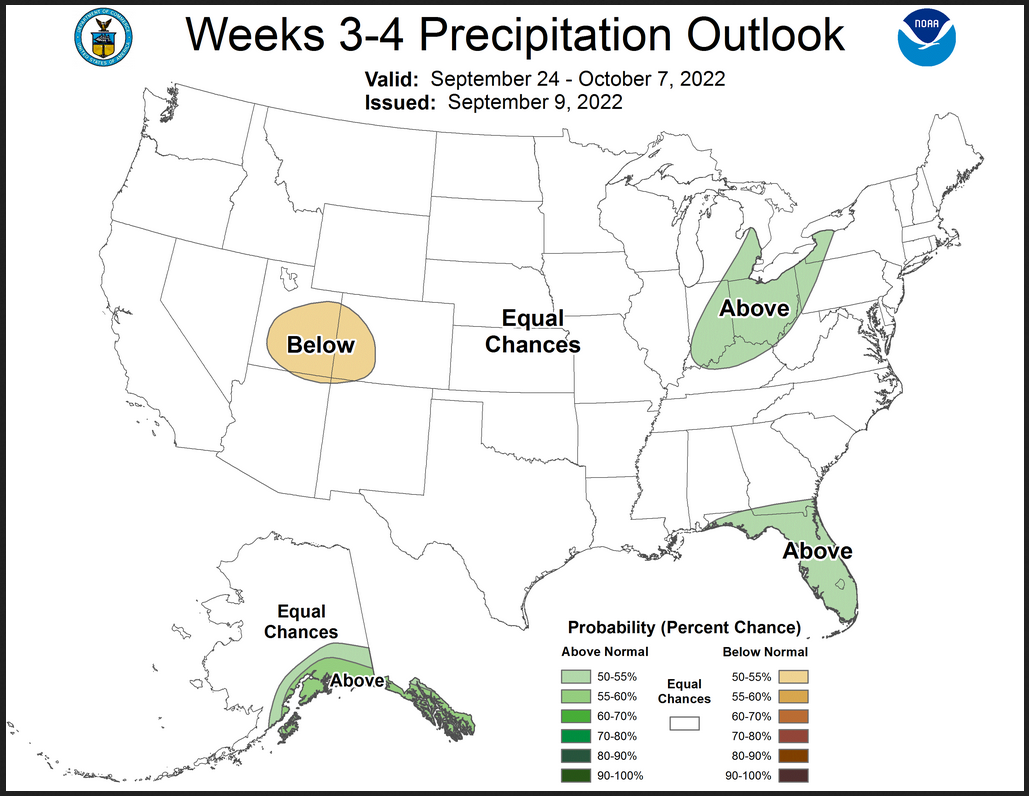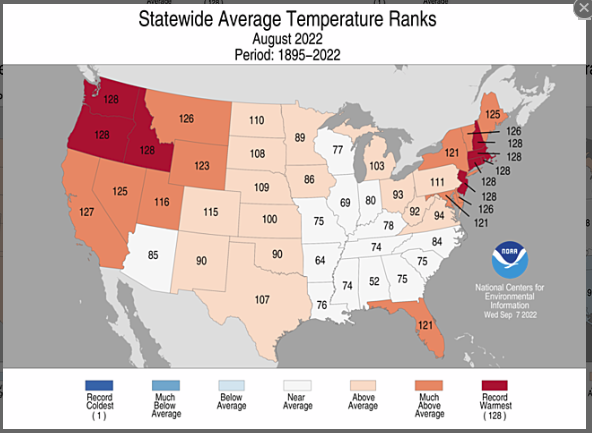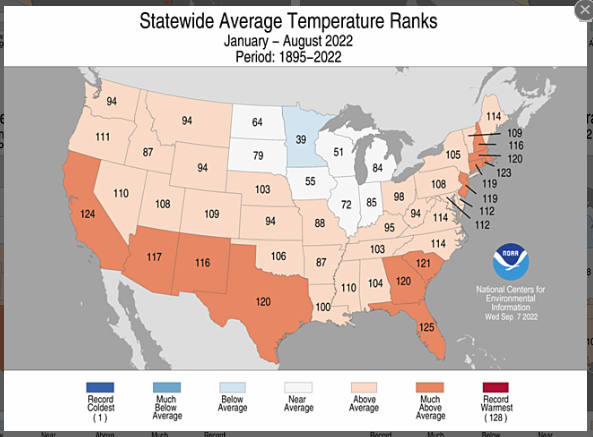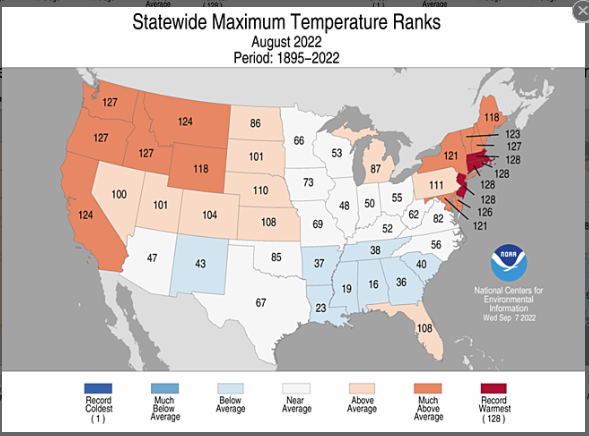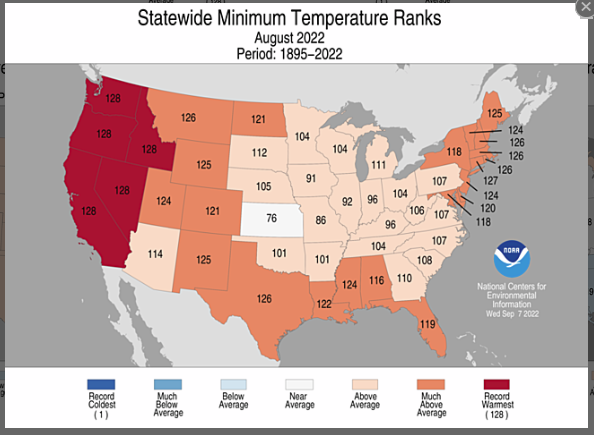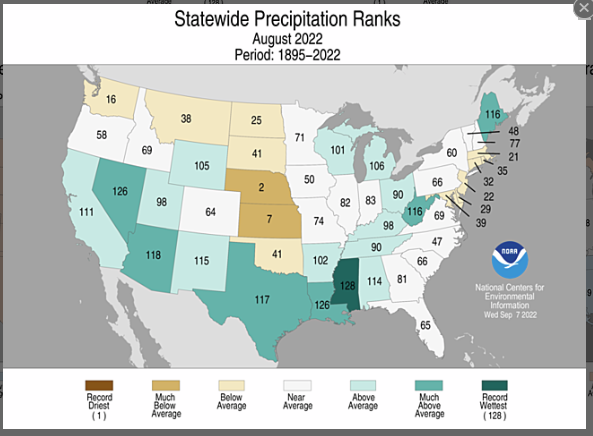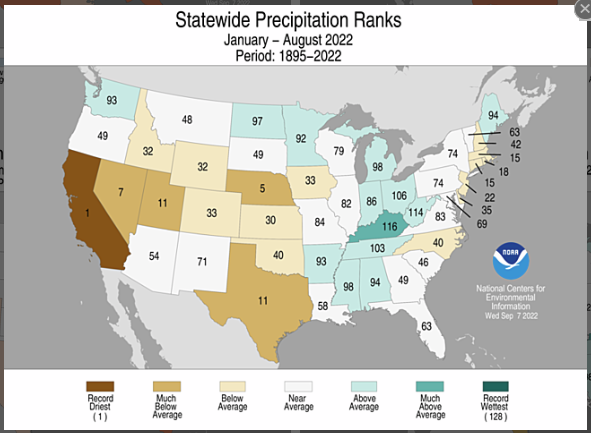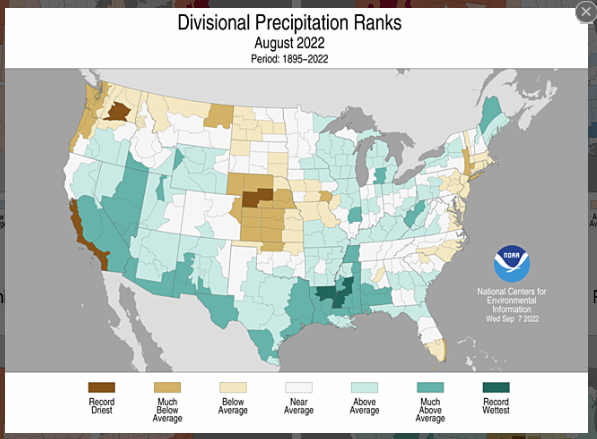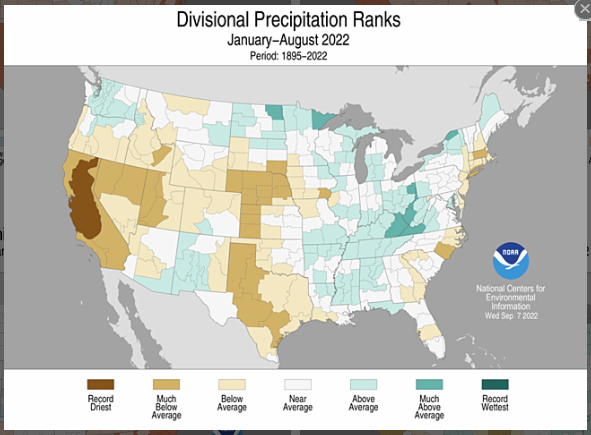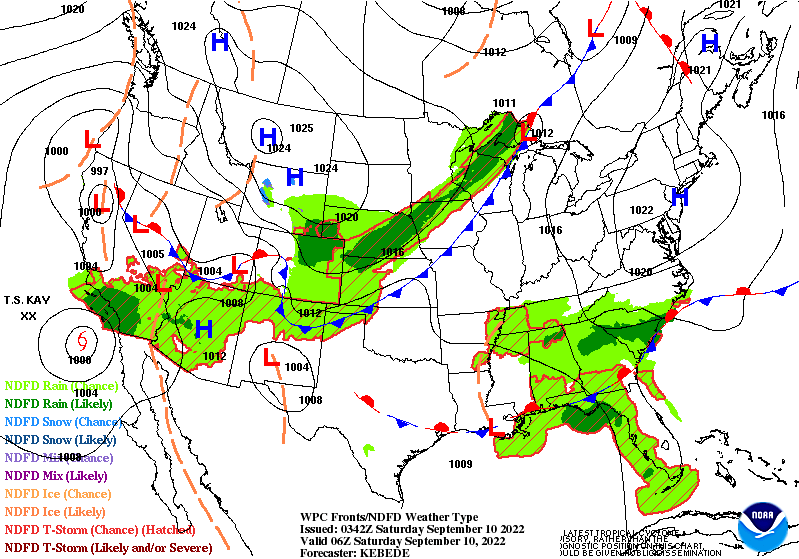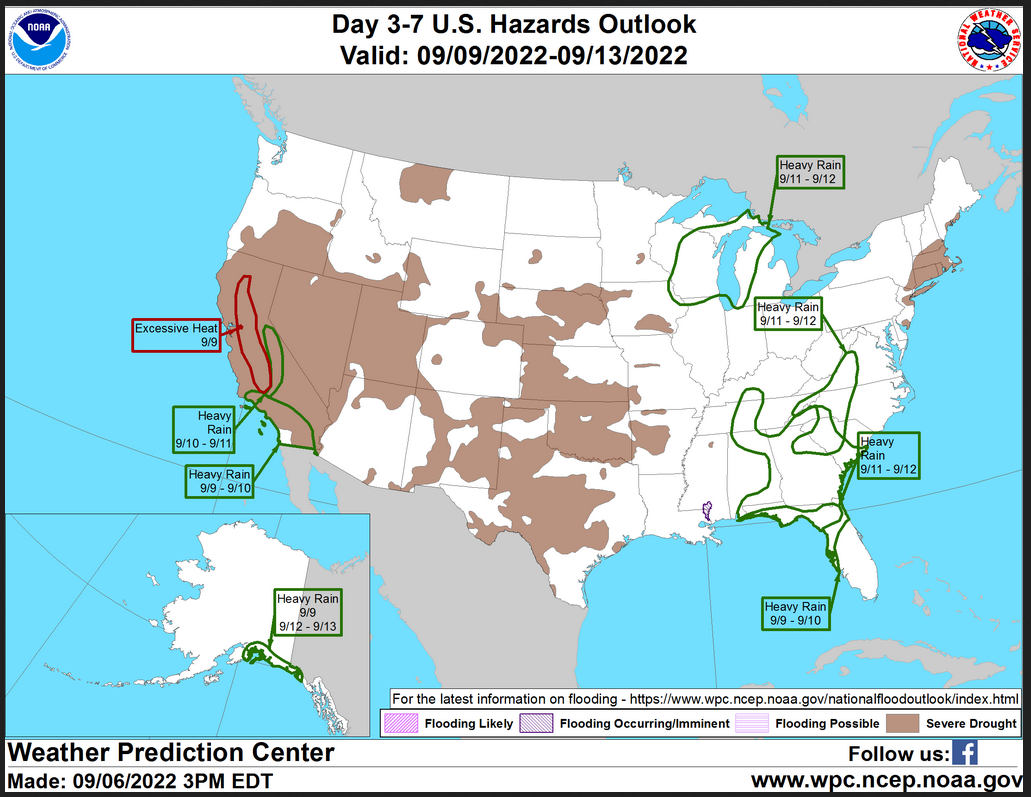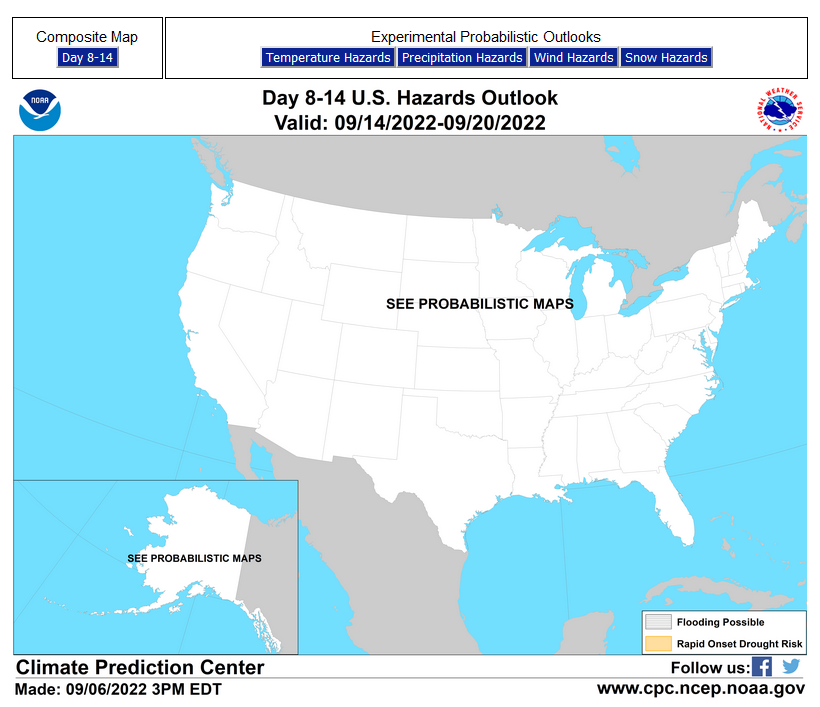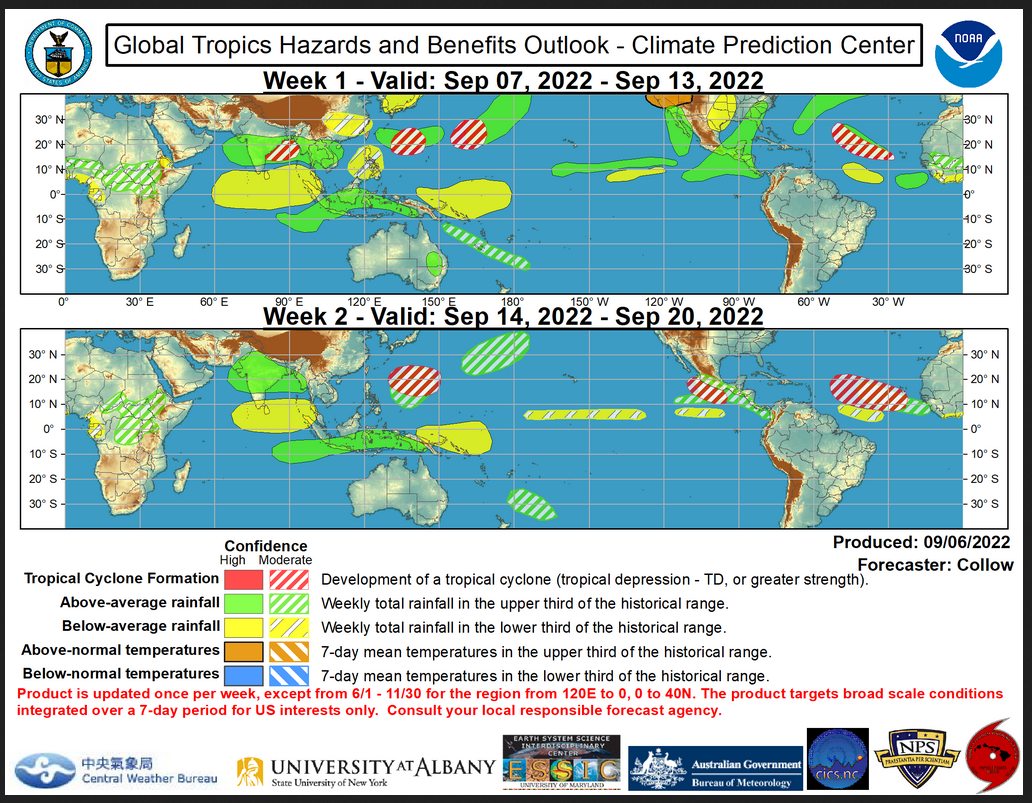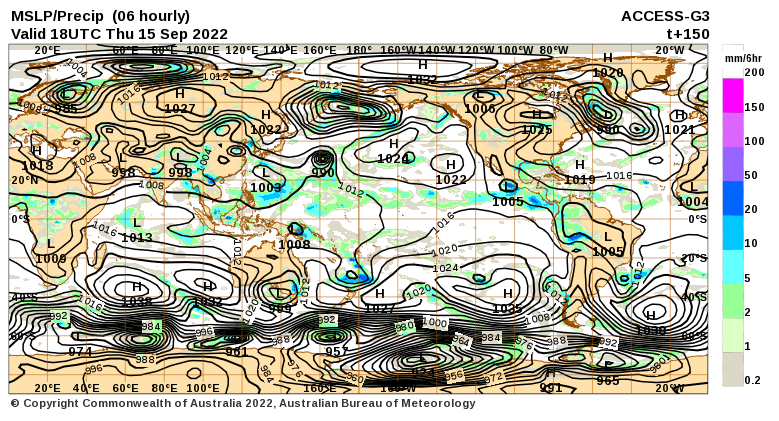After the first week, there is a change in the pattern with more moisture in the Northern Tier and more heat first in the Great Plains and then drifting to the East. The anomalies in the second half of the 28-day period moderate.
NOAA updates many of its weather outlooks daily or even more frequently and in many cases issues a discussion with those outlooks. We provide a daily report which focuses on the shorter-term predictions but has links to all the partial-month outlooks. One of the reports issued by NOAA only gets updated on Fridays and since this covers weeks 3 and 4 it is very important. The discussion that gets issued with this week 3-4 NOAA report is often where possible changes to the weather pattern are first identified.
So we have decided to issue a special report on Fridays (which most will read on Saturday) in which for a subset of the information, we show the actual forecast maps not just provide the links. This makes it easier for the reader. We will also include at the end of the article the other information from the daily article
When the Week 3-4 Outlook is issued on Friday, we have a 28-day view of the future. It is important to recognize that the forecasts do not always work out as predicted. But in the article, there are links to obtain updated forecasts. This is important because it appears that changes are happening and the current view of the next 28 days differs substantially from the Monthly Outlook issued just a few days ago.
The regular 48-hour forecast article is included in this article and follows the 28-Day Analysis.
This week we also show the state rankings for August and compare them to the state rankings year to date (YTD).

What NOAA is predicting for the next 28 days.
We will start with the short-term – It is up to date as of today. If you look at this article after today you can click the links to update (plus you will end up with a lot of additional information)
| Temperature (Maximum Anomaly) for the next five days | Precipitation (Five days of cumulative precipitation) |
| https://www.wpc.ncep.noaa.gov/medr/me dr_mean.shtml | https://www.wpc.ncep.noaa.gov/qpf/day1-7.shtml |
| Most of the warm temperature anomalies are in the Northwest. The precipitation is mostly in the Eastern half of CONUS. It is difficult to decide if Tropical Storm Kay is a remnant of the Monsoon but it is a short-term event. |
Now we look at “Outlook” maps for three time periods. Days 6 – 10, Days 8 – 14, and Weeks 3 and 4. An outlook differs from a forecast based on how NOAA uses these terms in that an “outlook” presents information as deviation from normal and the likelihood of these deviations.
I have provided the maps so you do not need to click to get them. But they do not update daily. But you can get the current images simply by clicking on the links provided. Then hit the return arrow at the upper left of your screen to return to the article. There is no need to do that right away since what is published today is up to date. The Week 3 – 4 Outlook only updates on Fridays.
Below are the links to obtain updates and additional information.
| The warm area has changed location a bit. It is more in the Central Plains but that can change. The precipitation is now in the Northwest and Alaska. |
| West-East divide re temperature and precipitation anomalies has been replaced with a NorthWest-SouthEast divide. |
Now we address Weeks 3 and 4. This is a time frame that is very important. It is half of the 28-Day forecast period. That is why we include the discussion that accompanies the maps.
Prognostic Discussion for Week 3-4 Temperature and Experimental Precipitation Outlooks
NWS Climate Prediction Center College Park MD
300PM EDT Fri Sep 09 2022
Week 3-4 Forecast Discussion Valid Sat Sep 24 2022-Fri Oct 07 2022
La Niña conditions continue to dominate tropical climate variability as the intraseasonal signal associated with the Madden Julian Oscillation (MJO) remains in a weakened state. Dynamical model forecasts of the Real-time Multivariate MJO (RMM) index continue to maintain a weak signal through the start of the outlook period. Extratropical teleconnections such as the North Atlantic Oscillation are currently in the negative phase but expected to transition to a more neutral state by the start of the forecast period. This week’s temperature and precipitation outlooks are based primarily on dynamical model guidance as well as considerations for La Niña-related impacts.
There is good agreement among the dynamical models (CFS, ECMWF, GEFS and the SubX multi-model ensemble) regarding the 500-hPa height anomaly pattern for the Week 3-4 period. Models all indicate broad anomalous ridging over the CONUS, particularly the northern tier. Across Alaska, anomalous troughing is anticipated, but the model solutions differ slightly with the CFS indicating stronger negative height anomalies than the other models which also place the trough farther west off the coast.
Similar to last week, the Week 3-4 temperature forecast tilts toward above normal temperature probabilities across much of the CONUS under the broad ridging. Highest probabilities are along the East Coast, particularly the mid-Atlantic region where model agreement is strongest. Above normal probabilities are lower for the Midwest and Mississippi valley where the CFS indicates weakly negative temperatures for the period. Equal Chances (EC) of above or below normal temperature probabilities are forecast for both western CONUS and the upper Midwest where model signals are weak. Across Alaska, enhanced probabilities of above normal temperatures are favored under southerly flow.
The precipitation forecast continues to reflect the relatively weak and conflicting signals among the dynamical and statistical guidance. Model agreement is strongest with regard to the above median precipitation probabilities for the South Coast and Panhandle of Alaska in association with the southerly/onshore flow. Above median conditions are also favored for Florida and the Ohio Valley/Lower Great Lakes regions. A slight tilt toward anomalous dry conditions is forecast for parts of Utah and Colorado in relation to a weak ridge axis. Some dynamical models hint at above normal precipitation in the Southeast, but the typical precipitation anomalies associated with La Niña would suggest drier than normal conditions this time of year.
Above normal temperature temperature probabilities are favored for Hawaii with highest probabilities for the northwestern islands surrounded by elevated sea surface temperature (SST) anomalies. Model guidance is mixed regarding the precipitation signal so EC conditions are forecast with a slight tilt toward below normal precipitation for Honolulu and Lihue.
| The extremes are shown on the maps and described in the text. It is important to note that the Week 3 -4 Outlook is prepared by a different team than the 6 -10 and 8 – 14 day Outlooks. |
Now we look at August last year and the YTD through August 2022.
The state rankings show where for each state, their weather for the single month of August on the left and their year-to-date (YTD) weather on the right fits within their 128-year modern set of data which is considered the most reliable. They are color-coded to make them easier to read. It may tell us something about how a La Nina behaves as it weakens and dies.
| August 2022 |
Year to Date 2022 |
|
|
|
|
|
|
|
|
|
|
|
|
|
|
|
| There is a tremendous difference between August and the YTD situation. Temperature records were set in August in a number of states. The state precipitation rankings for the West were to some extent the opposite to the rankings YTD. I am sorry that I did not set the graphics up to be able to be enlarged. |
Now switching over to Part II of this article which is our regular 48-Hr Forecast which also includes links for tropical updates.
Here is what we are paying attention to today and the next 48 hours from this morning’s NWS Forecast.
(It is updated twice a day and these updates can be found here.
...Kay continues to weaken, but heavy rainfall and flash flooding remain a threat for portions of southern California and the Desert Southwest... ...The record breaking heat across much of the West comes to an end, but an elevated risk of Fire Weather will continue in the Pacific Northwest... ...Heavy Rain possible in the Midwest, Mid-Atlantic and Florida Gulf Coast... ...Strong cold front to bring much cooler temperatures to the Plains and Upper/Middle Mississippi Valley... Kay weakened to a post tropical cyclone this morning, but is forecast to continue streaming anomalous moisture into southern California and the Desert Southwest as it continues to wobble its way farther into the eastern Pacific this weekend. Bands of heavy rain and thunderstorms moving through the Southwest may produce flash flooding, especially over areas with sensitive soils. A slight risk of excessive rainfall is in effect for parts of interior southern California, southern Nevada and northwestern Arizona today. High temperatures will remain below average while lows are above average this weekend thanks to the increased cloud cover from Kay. The upper ridge responsible for record breaking heat across the West will shift east a bit in response to an upper low approaching the Pacific Northwest. Both of these upper level features will combine to produce above average temperatures across the Northwest this weekend. Fortunately, none of this warm weather will break records, but there's an elevated risk of fire weather. Red Flag warnings are in effect for much of the Pacific Northwest. An amplified trough will close off into an upper low over the Midwest this weekend. This upper low and attendant surface cold front will be the focus for heavy rainfall from the Mississippi Valley/Great Plains today to the Upper Midwest on Sunday. A slight of excessive rainfall is in effect for parts of southern Wisconsin on Sunday as a result. A much colder airmass swoops through on the backside of the strong cold front, dropping temperatures 20-30 degrees below average over parts of the Central Southern Plains today before expanding into the Midwest and Middle Mississippi Valley on Sunday. Unsettled weather will materialize along the base of the aforementioned upper trough today and continue into next week. Shortwave energy is forecast to help transport a firehose of tropical moisture from the Southeast up into the Mid-Atlantic and Midwest for the next few days. Heavy rainfall and thunderstorms are the likely outcome across the region. Slight risks of excessive rainfall are in effect for portions of the Central Appalachians down into the Carolina piedmont/tidewater as well as the Florida Gulf Coast today before the focus for heavy rain shifts into the Raleigh-Philadelphia I-95 corridor on Sunday.
Maps that relate the forecast to geography can be found by clicking Here for Day 1 and Here for Day 2.
Here is a 60-hour animated forecast map that shows how the short-term forecast is expected to play out.
If it needs to be updated click here.
HAZARDS OUTLOOKS
Click here for the latest complete Day 3 -7 Hazards forecast which updates only on weekdays. Once a week probably Monday or Tuesday I will update the images. I provided the link for readers to get daily updates on weekdays. Use your own judgment to decide if you need to update these images.
Worldwide Tropical Forecast
(This graphic updates on Tuesdays) If it has not been updated, you can get the update by clicking here
Detailed Maps and Reports for the Western Atlantic and the Pacific Oceans
Below are three maps that summarize the situation for the Atlantic, Eastern and Central Pacific. Additional information can be accessed by clicking HERE
First the Atlantic
Click to view the forecast map and have access to additional information https://www.nhc.noaa.gov/gtwo.php ?basin=atlc&fdays=5
Then Eastern Pacific
Click to view the forecast map and have access to additional information https://www.nhc.noaa.gov/gtwo.php?basin=epac&fdays=5
Then Central Pacific
Click to view the forecast map and have access to additional information https://www.nhc.noaa.gov/gtwo.php?basin=cpac&fdays=5
And the Western Pacific
Click to view the forecast map and have access to additional information https://www.metoc.navy.mil/jtwc/jtwc.html
World Forecast for Day 6 (Currently Set for Day 6 but the reader can change that)
World Weather Forecast produced by the Australian Bureau of Meteorology. Unfortunately, I do not know how to extract the control panel and embed it into my report so that you could use the tool within my report. But if you visit it Click Here and you will be able to use the tool to view temperature or many other things for THE WORLD. It can forecast out for a week. Pretty cool. Return to this report by using the “Back Arrow” usually found top left corner of your screen to the left of the URL Box. It may require hitting it a few times depending on how deep you are into the BOM tool. Below are the current worldwide precipitation and air pressure forecasts for six days out. They will not auto-update and right now are current for Day 6. If you want the forecast for a different day Click Here I will try to update this map each day but you have the link so you can access the dashboard and get a wide variety of forecasts.I mostly rely on the reader to interpret world maps. For this map, areas of expected precipitation for the date and time shown are clearly shown. The number of High-Pressure systems shown is called the Wave Number. Maybe I will discuss WN someday. But it shows how many Rossby Waves there are around the World. Sometimes they are hard to count. Counting Low-Pressure systems should provide the same WN. Rossby Waves are the way the temperature distribution of the Planet remains in balance. It is basically the science of fluid dynamics. It can be very helpful in predicting the movement of weather patterns. You can snip an area of interest and move it into MS Paint and enlarge it.
Month to Date Information
Month to date Temperature can be found at https://hprcc.unl.edu/products/maps/acis/MonthTDeptUS.png
Month to date Precipitation can be found at https://hprcc.unl.edu/products/maps/acis/MonthPNormUS.png

